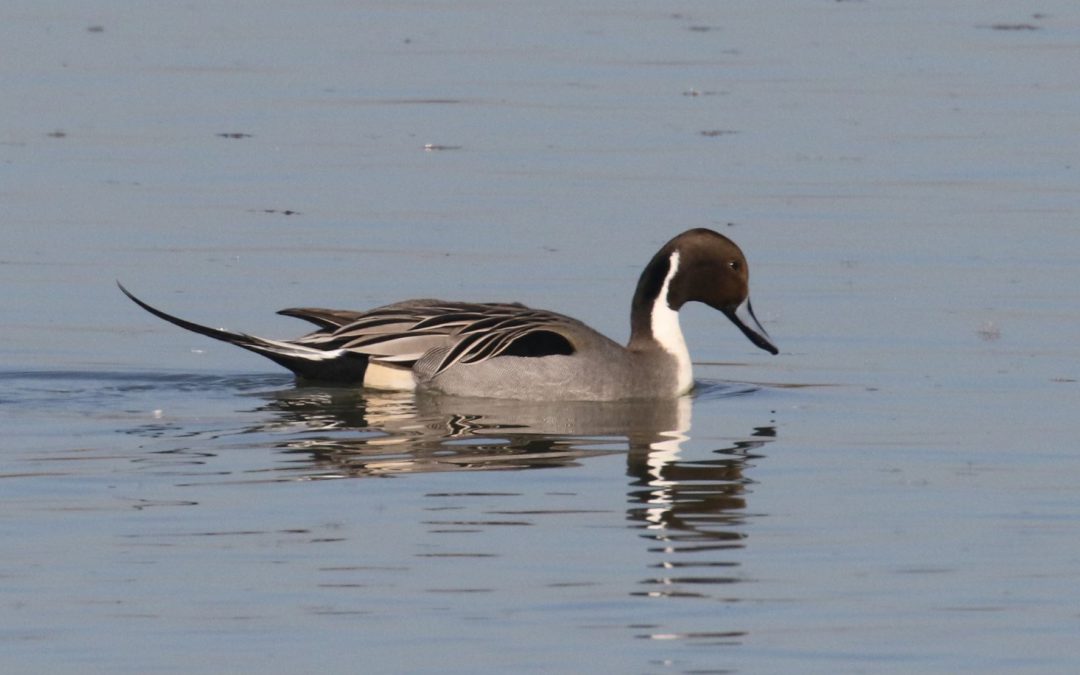We may live in England’s smallest county but we are blessed with one of the best reserves in the entire country.
February 10th Egleton Bird Reserve Craig and Samantha Howat
It was a lovely still, warm springtime morning, more akin to April than February when we arrived at Egleton. The Rookery was noisily alive with the adult birds already nesting, for this worm-eating species of crow takes advantage of the wet conditions and abundance of worms in early spring to feed its chicks. This winter had already seen twice the normal winter rainfall and hopefully it will be a successful nesting year for this overlooked species.
The chorus of songbirds were also responding to the spring weather with the Wren’s (explosive song), Dunnocks, Reed Bunting, Great and Blue Tit, Goldcrest, the yaffling of a Green Woodpecker, and the drumming of a Great Spotted Woodpecker echoing around the old meadows at Egleton. Unfortunately, the leader had forgotten his binoculars and had to rush back to the car where a Buff-tailed Bumble Bee flew by. This species had been noted during December and January even when it snowed, with one “buzzing” me as I made a snowman! This is confirming a growing trend observed of this species being active all year round rather than hibernating.
February is a good time to listen for Song Thrushes, who actively sing during this time of year, and it is a good opportunity to monitor the number of territories. There were six singing birds between the carpark and Lagoon 4. The Song Thrush does appear to be out of sync with other songbirds as it is quieter during the maximum spring dawn chorus of late April and May but starts again throughout July, filling the dark green woods of summer with their song when other songsters have gone quiet.
The mild wet weather meant there was still several fungi and slime moulds to be found with Candlesnuff, Yellowbrain, Jelly Ear and Turkeytail growing amongst the woodpiles and fallen branches.
At Grebe Hide on lagoon 2, we observed a small group of Teal displaying, with the males noisily circling each other, whilst quickly raising stretched necks and heads, then bobbing down, followed by quickly raising their tails to flash their yellow undertail coverts.
In the reedmace a Stonechat was seen perched on top of the reedmace. This upland chat overwinters in lowland marshes looking for invertebrates like its cousin the Bluethroat does in the marshes on north Africa. Another uncommon wintering bird was the Green Sandpiper that was found quietly patrolling the far bank. Recent telemetry studies have shown these birds come from their breeding grounds in Scandinavia, mostly the forests of Sweden and Finland, where they breed around pools in forest clearings. Their most south-easterly breeding sites are on the north-east forests of Zealand in Denmark.
A pair of Goosander were found cruising between the islands. The drake bird plumage can be strongly blushed with a pinkish-salmon colour. It is a large sawbill whose serrated bill is designed to catch fish but sadly, this impressive duck is under persecution in its breeding habitat of upland UK rivers where it is blamed for predating salmon and trout stocks.
Many of the waterfowl were in clusters, where diving Coots were intermingled with Wigeon and Gadwall that were quickly pecking up any fragments of weed floating to the surface from the activity of the diving Coots. Small numbers of Goldeneye and Tufted Ducks also dived on the edge, looking for small molluscs.
Although we heard a small party of Siskins in the Alders they only stopped by briefly. The seeds in the Alder cones had largely been exhausted by the finch flocks which then move on to the garden feeders. The Alder catkins were forming.
We only saw one Grey Squirrel, though there were numerous signs throughout the walk of the activity of mammals, from the numerous Badger setts and latrines and the runs of Muntjac and mole hills. On the bank of lagoon 4, near a well-worn run leading to lagoon 3, Linda found some Otter footprints to confirm the maker and under Sandpiper Hide a Fox had dug a large hole beneath the hide.
From Sandpiper Hide some of us managed to see in the distance, the ‘redhead’ Smew diving along the distant reedbed. Other wintering species were found here too, including four Pintail, flocks of Wigeon (147) and Lapwings (346) and one solitary Golden Plover. There were 2 Great White Egrets present showing that this once rare species at RW only 6 years ago, has become a well-established species. Two pairs of Oystercatchers were another welcome sign of spring.
On our return to the centre the bubbling calls of Curlew could be heard and there was a flock of 7 on Lagoon 1 from the centre. An all-dark Marsh Harrier cruised along just outside the viewing platform which was a good ending to a very pleasant mornings walk.
